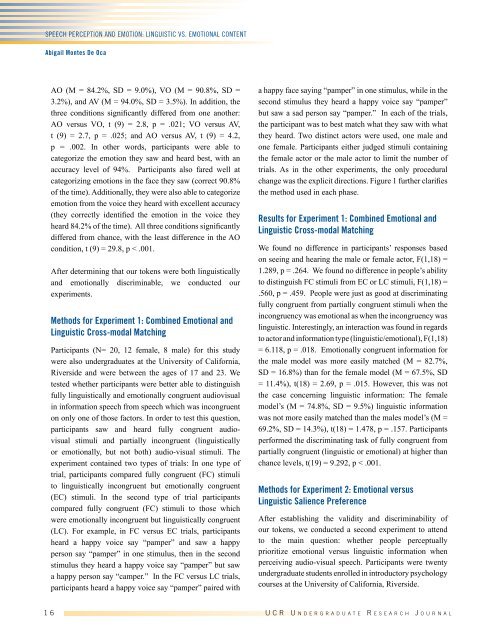Undergraduate Research Journal
Undergraduate Research Journal
Undergraduate Research Journal
You also want an ePaper? Increase the reach of your titles
YUMPU automatically turns print PDFs into web optimized ePapers that Google loves.
Speech Perception and Emotion: Linguistic vs. Emotional Content<br />
Abigail Montes De Oca<br />
AO (M = 84.2%, SD = 9.0%), VO (M = 90.8%, SD =<br />
3.2%), and AV (M = 94.0%, SD = 3.5%). In addition, the<br />
three conditions significantly differed from one another:<br />
AO versus VO, t (9) = 2.8, p = .021; VO versus AV,<br />
t (9) = 2.7, p = .025; and AO versus AV, t (9) = 4.2,<br />
p = .002. In other words, participants were able to<br />
categorize the emotion they saw and heard best, with an<br />
accuracy level of 94%. Participants also fared well at<br />
categorizing emotions in the face they saw (correct 90.8%<br />
of the time). Additionally, they were also able to categorize<br />
emotion from the voice they heard with excellent accuracy<br />
(they correctly identified the emotion in the voice they<br />
heard 84.2% of the time). All three conditions significantly<br />
differed from chance, with the least difference in the AO<br />
condition, t (9) = 29.8, p < .001.<br />
After determining that our tokens were both linguistically<br />
and emotionally discriminable, we conducted our<br />
experiments.<br />
Methods for Experiment 1: Combined Emotional and<br />
Linguistic Cross-modal Matching<br />
Participants (N= 20, 12 female, 8 male) for this study<br />
were also undergraduates at the University of California,<br />
Riverside and were between the ages of 17 and 23. We<br />
tested whether participants were better able to distinguish<br />
fully linguistically and emotionally congruent audiovisual<br />
in information speech from speech which was incongruent<br />
on only one of those factors. In order to test this question,<br />
participants saw and heard fully congruent audiovisual<br />
stimuli and partially incongruent (linguistically<br />
or emotionally, but not both) audio-visual stimuli. The<br />
experiment contained two types of trials: In one type of<br />
trial, participants compared fully congruent (FC) stimuli<br />
to linguistically incongruent but emotionally congruent<br />
(EC) stimuli. In the second type of trial participants<br />
compared fully congruent (FC) stimuli to those which<br />
were emotionally incongruent but linguistically congruent<br />
(LC). For example, in FC versus EC trials, participants<br />
heard a happy voice say “pamper” and saw a happy<br />
person say “pamper” in one stimulus, then in the second<br />
stimulus they heard a happy voice say “pamper” but saw<br />
a happy person say “camper.” In the FC versus LC trials,<br />
participants heard a happy voice say “pamper” paired with<br />
a happy face saying “pamper” in one stimulus, while in the<br />
second stimulus they heard a happy voice say “pamper”<br />
but saw a sad person say “pamper.” In each of the trials,<br />
the participant was to best match what they saw with what<br />
they heard. Two distinct actors were used, one male and<br />
one female. Participants either judged stimuli containing<br />
the female actor or the male actor to limit the number of<br />
trials. As in the other experiments, the only procedural<br />
change was the explicit directions. Figure 1 further clarifies<br />
the method used in each phase.<br />
Results for Experiment 1: Combined Emotional and<br />
Linguistic Cross-modal Matching<br />
We found no difference in participants’ responses based<br />
on seeing and hearing the male or female actor, F(1,18) =<br />
1.289, p = .264. We found no difference in people’s ability<br />
to distinguish FC stimuli from EC or LC stimuli, F(1,18) =<br />
.560, p = .459. People were just as good at discriminating<br />
fully congruent from partially congruent stimuli when the<br />
incongruency was emotional as when the incongruency was<br />
linguistic. Interestingly, an interaction was found in regards<br />
to actor and information type (linguistic/emotional), F(1,18)<br />
= 6.118, p = .018. Emotionally congruent information for<br />
the male model was more easily matched (M = 82.7%,<br />
SD = 16.8%) than for the female model (M = 67.5%, SD<br />
= 11.4%), t(18) = 2.69, p = .015. However, this was not<br />
the case concerning linguistic information: The female<br />
model’s (M = 74.8%, SD = 9.5%) linguistic information<br />
was not more easily matched than the males model’s (M =<br />
69.2%, SD = 14.3%), t(18) = 1.478, p = .157. Participants<br />
performed the discriminating task of fully congruent from<br />
partially congruent (linguistic or emotional) at higher than<br />
chance levels, t(19) = 9.292, p < .001.<br />
Methods for Experiment 2: Emotional versus<br />
Linguistic Salience Preference<br />
After establishing the validity and discriminability of<br />
our tokens, we conducted a second experiment to attend<br />
to the main question: whether people perceptually<br />
prioritize emotional versus linguistic information when<br />
perceiving audio-visual speech. Participants were twenty<br />
undergraduate students enrolled in introductory psychology<br />
courses at the University of California, Riverside.<br />
1 6 U C R U n d e r g r a d u a t e R e s e a r c h J o u r n a l














